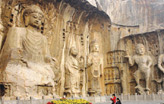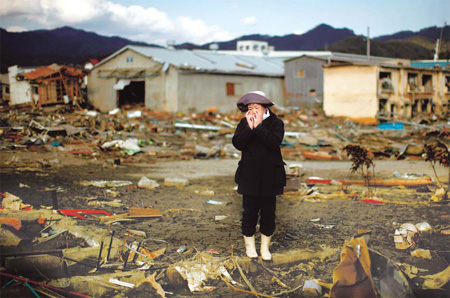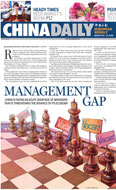Asia
Highly radioactive water leaks from nuclear plant
Updated: 2011-03-29 07:57
(China Daily)
|
A woman reacts while using a mobile phone as she looks at her house destroyed by the earthquake and tsunami in Kessenuma town, Miyagi prefecture, on Monday. Carlos Barria / Reuters |
TOKYO - Highly radioactive water has leaked from a reactor at Japan's crippled nuclear complex, the plant's operator said on Monday, while environmental group Greenpeace said it had detected high levels of radiation outside an exclusion zone.
Reflecting growing unease about efforts to control the six-reactor Fukushima Daiichi complex, plant operator Tokyo Electric Power Co (TEPCO) had appealed to French companies for help, the Kyodo news agency said.
The plant, 240 km north of Tokyo, was damaged in a March 11 earthquake and tsunami that left more than 27,000 people dead or missing across northeast Japan.
Fires, explosions and radiation leaks have repeatedly forced engineers to suspend efforts to stabilize the plant, including on Sunday when radiation levels spiked to 100,000 times above normal in water inside reactor No 2.
A partial meltdown of fuel rods inside the reactor vessel was responsible for the high levels of radiation at that reactor although Chief Cabinet Secretary Yukio Edano said the radiation had mainly been contained in the reactor building.
TEPCO later said radiation above 1,000 millisieverts per hour was found in water in tunnels used for piping outside the reactor.
That is the same as the level discovered on Sunday. The US Environmental Protection Agency says a single dose of 1,000 millisieverts is enough to cause haemorrhaging. TEPCO officials said the underground tunnels did not flow into the sea, but the possibility of radioactive water seeping into the ground could not be ruled out.
Greenpeace said its experts had confirmed radiation levels of up to 10 microsieverts per hour in a village 40 km northwest of the plant. It called for the extension of a 20-km evacuation zone.
"It is clearly not safe for people to remain in Iitate, especially children and pregnant women, when it could mean receiving the maximum allowed annual dose of radiation in only a few days," Greenpeace said in a statement, referring to the village where the radiation reading was taken.
More than 70,000 people have been evacuated from an area within 20 km of the plant, and another 130,000 people within a zone extending a further 10 km are recommended to stay indoors. They have been encouraged to leave.
Beyond the evacuation zone, traces of radiation have turned up in tap water in Tokyo and as far away as Iceland.
Japanese officials and international experts have generally said the levels away from the plant are not dangerous for humans, who anyway face higher radiation doses on a daily basis from natural substances, X-rays or flights.
But Greenpeace urged the government to acknowledge the danger: "The authorities must stop choosing politics over science."
On the weekend, the spike in radiation levels forced a suspension of work at the reactor, with experts warning that Japan faced a long fight to contain the world's most dangerous atomic crisis in 25 years.
"This is far beyond what one nation can handle - it needs to be bumped up to the UN Security Council," said Najmedin Meshkati, of the University of Southern California. "In my humble opinion, this is more important than the Libya no-fly zone."
Reuters
E-paper

Rise and shine
The Chinese solar energy industry is heating up following recent setbacks in the nuclear sector
Bombs aim for regime change
CSI, with a twist
Literary path
Specials

Peony express
Growers of china's unofficial national flower are reaching out to europe for help

Tea-ing up
More turning to Chinese tea for investment opportunities like vintage wine

A cut above
The ancient city of Luoyang is home to a treasure trove of cultural wonders.

